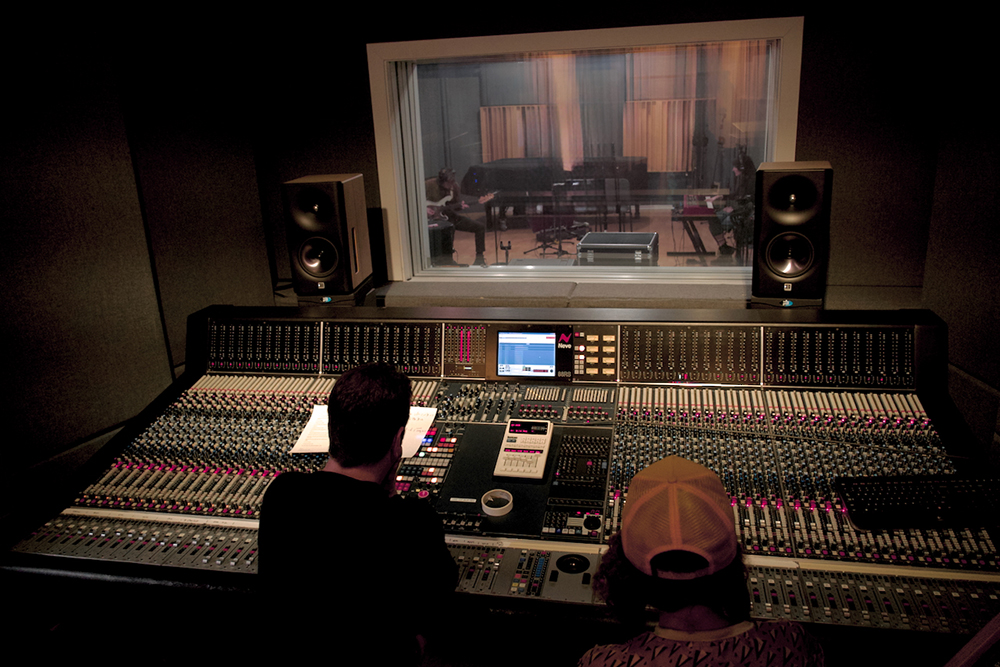Facilities & Equipment
Studio A
Rm. 220, Conservatory Building

Control Room
- Console: Neve 88RS
- Monitoring: Dutch & Dutch 8C
- Digital Audio Workstations:
- Microphone Preamplifiers: Neve, Manley Labs, API, Great River, Earthworks, and Joe Meek.
- Analog Outboard Processing:
- Equalizers: API 5500, 550A and 560; Chandler Little Devil EQ; Lang PEQ2.
- Dynamics: UREI 1178 and LA4; Chandler Little Devil Compressor; Empirical Labs Distressor, and Little Fatso Jr; SPL Transient Designer.
- Reverb/Delay Hardware
- Lexicon 960, EMT 240 Plate, AKG BX-20E Spring, TC Electronic 2290.

Studio
- Steinway D Concert Grand Piano
- Yamaha Maple Nouveau Drum kit
- Hammond B3 Organ
- Amplifiers: Aguilar, Fender, Vox
- Headphone Monitoring: Digital Audio Labs
Studio B
Rm. 203 Conservatory Building

- Avid S6 Control Surface
- D.A.V. Microphone Preamps
- SPL Mix Dream
- Digital Audio Workstation:
- Avid Pro Tools HDX using a DAD/MTRX interface
- (See Studio A description for Plugin list)
- 7.1.4 Genelec Atmos Monitoring
- Marantz Preamp
- Apple TV: Apple Music, Netflix
Studio C
Leakin Hall Basement

- Lawo MC256 mkII interfaced with analog as well as digital audio via AES/EBU, and Dante and Ravenna audio-over-IP.
- Digital Audio Workstations
- Avid Pro Tools HDX and Pyramix.
- (See Studio A description for Plugin list)
- Monitoring: Revel Studio2 full range loudspeakers powered by two McIntosh MC601 monoblock amplifiers.
- Video: Apple Final-Cut Pro HD.
- Outboard: Lexicon PCM81 and PCM91, Sony DRE-777 Sampling Reverb, DPS-F7’s, DPS-M7, and DPS-V55.
- EMT 140 Plate Reverb
Studio D
Leakin Hall Basement

- API 1604 Console
- Monitoring: Pelonis 4288
- Digital Audio Workstation
- Avid Pro Tools HDX
- (See Studio A description for Plugin list)
- Video: Apple Final-Cut Pro HD.
- Otari MTR-90 Mk II 2” 24-tk with Dolby SR noise reduction, MTR-10, Sony
- Outboard: Drawmer DS201 gates, T.C. Electronics TC1210, Valley Electronics Gain Brain II’s, Kepex II’s, Commander’s, UREI model 546 equalization, and DBX 180 Type I NR.
- Keyboards: Moog Voyager, Nord Stage EX
Microphones
All Studios share one of the most comprehensive microphone collections comparable to the world’s best recording studios.
- Neumann M-147, M-149, and M-150 tube microphones in addition to solid state KM84, KM85, KM86, KM140, U-87, TLM103, TLM170, TLM93, KM81r line, SM69 stereo, KU100 “Fritz” Binaural Head.
- Sennheiser moving coil MD-441 andMD-421, condensers MKH series 20, 30, 40, 8000, 8020, 8040 and 8050 microphones
- AKG C-414P48, C-414TLII, C-414EB, C-4000B, “The Tube”, and C-422 stereo
- Shure moving-coils SM57, SM7B, Beta 91A, ribbons KSM353
- ElectroVoice RE20
- Audio Technica AT-4050 mics
- Beyer ribbon M-160, M-260, M-500, and moving coil M-88
- Coles 4038 ribbon microphones
- DPA 4006 and 4011
- Microtech-Geffell UM70, M300, M-296, and M-930
- Royer R-121 and SF-24
- Josephson C700S B-format ambisonic, E22
- Townsend Labs Sphere
- Rode NTSF1 A-format ambisonic
Portable Outboard Equipment in Road Cases
- Microphone Preamplifiers: 24 channels of Millennia Media HV3R coupled with RME M32AD, MADI outputs; 24 channels of Grace M108 coupled with M-32 AD Pro II, MADI and Dante outputs.
- Equalizer: Manley Labs Massive Passive
- Dynamics: Manley Vari-Mu; UREI 1176, LA2A; dbx 160; Alan Smart C2; API 2500+; SSL X-Logic Bus Compressor.